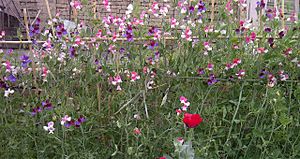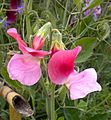Sweet pea facts for kids
Quick facts for kids Sweet pea |
|
|---|---|
 |
|
| Scientific classification | |
| Kingdom: | |
| (unranked): | |
| (unranked): | |
| (unranked): | |
| Order: | |
| Family: | |
| Subfamily: | |
| Tribe: |
Vicieae
|
| Genus: |
Lathyrus
|
| Species: |
L. odoratus
|
| Binomial name | |
| Lathyrus odoratus |
|
The sweet pea, also known as Lathyrus odoratus, is a beautiful flowering plant. It belongs to the Fabaceae family, which includes legumes like peas and beans. This plant originally comes from Sicily, southern Italy, and the Aegean Islands.
Sweet peas are annual climbing plants. This means they grow, flower, and produce seeds all in one year. They can grow quite tall, reaching about 1 to 2 meters (3 to 6 feet) if they have something to climb on. Their leaves have two small parts and a curly "tendril" at the end. This tendril wraps around other plants or structures, helping the sweet pea climb upwards. Wild sweet pea flowers are usually purple and about 2 to 3.5 centimeters (1 to 1.5 inches) wide. However, there are many different types (called cultivars) with larger flowers in various colors. Sweet pea flowers are famous for their strong, sweet smell.
It's important not to confuse the annual sweet pea (L. odoratus) with the everlasting pea (L. latifolius), which is a plant that lives for many years.
Contents
Growing Sweet Peas: A History
The sweet pea became very popular thanks to a Scottish gardener named Henry Eckford (1823–1905). He worked hard to cross-breed different sweet peas. He changed them from small, simple flowers into the amazing, scented blooms we know today.
Eckford first became known for growing new types of pelargoniums and dahlias. In 1882, he received a top award for a sweet pea type called 'Bronze Prince'. This marked the start of his special connection with the flower. In 1888, he set up his sweet pea growing fields in Wem, England. By 1901, he had created 115 of the 264 different sweet pea types grown at that time! For all his work, Eckford received a special medal. He passed away in 1906, but his son, John Eckford, continued his work for a while.
Today, the town of Wem still celebrates its link to sweet peas and the Eckford family. The Sweet Pea Society of Wem holds an annual show. Many street signs in Wem have a sweet pea design, and a park is named Eckford Park. There's even a sweet pea type called 'Dorothy Eckford', named after one of his family members.
How to Grow Sweet Peas
People have been growing sweet peas since the 1600s. Today, you can find many different types (cultivars) to buy. Gardeners love them for their beautiful colors, which often include soft shades of blue, pink, purple, and white. They are also grown for their amazing, unique smell. People grow them in their gardens for fun, for flower shows, or for selling as cut flowers.
You can plant the large, pea-shaped seeds in a cold frame in spring or autumn. It helps to soak the seeds in water or gently nick them with a sharp blade before planting. You can also buy young sweet pea plants later in the season. Sweet peas need support to climb, like canes or a fence. To make the plant bushy and get more flowers, you should regularly pinch off the tips of new shoots. Sweet peas usually grow 1 to 2 meters tall. Their flowers bloom in midsummer and can keep appearing for many weeks if you regularly remove the faded flowers (this is called deadheading).
More than 50 types of sweet peas have won a special award for being excellent garden plants. You can find a list of these award-winning types.
Sweet Pea Pests and Diseases
Sweet pea plants can sometimes get sick or be bothered by pests. The most common pests are aphids, also known as greenfly. These tiny insects suck the sap from the plants, which can make them grow less. Greenfly can also spread a Mosaic virus that causes leaves to turn yellow, new shoots to twist, and fewer flowers to grow.
Another pest is the pollen beetle. These small, shiny black beetles eat the pollen and can damage the look of the flowers. Other common pests include caterpillars, thrips, slugs, and snails. Sweet peas can also get mildew, which looks like a white powder covering the leaves and can slow down the plant's growth.
Sweet peas are also sensitive to a gas called ethylene. This gas is produced by plants that are getting old or dying. Because of this, it's a good idea to plant sweet peas away from fruit trees or other plants that tend to die back early.
Are Sweet Peas Safe to Eat?
Unlike the regular peas we eat, the seeds of sweet peas are not safe to eat in large amounts. If someone eats a lot of sweet pea seeds, it can cause a condition called lathyrism. This condition can cause problems with bones and joints.
Scientists have studied this in rats. They found that rats fed a diet with a lot of sweet pea seeds developed problems. The main issue seems to be with how the body makes collagen, which is an important protein in skin and other tissues. Sweet pea seeds contain a chemical that stops collagen from forming correctly. This can lead to loose skin. Scientists are even looking into using this chemical to help skin heal better after skin grafts.
Sweet Peas and Genetics
Gregor Mendel is known as the "Father of Modern Genetics" because of his work with cross-breeding different types of pea plants. Sweet peas have also been very important in understanding genetics. They were used in early experiments by a famous geneticist named Reginald Punnett.
Sweet peas are great for studying genetics because they can pollinate themselves. Also, their traits, like flower color, plant height, and petal shape, are easy to see and follow. Many important ideas about how genes work were first discovered or confirmed using sweet peas. For example, Punnett used them to study how genes can be linked together. Scientists also learned about "complementary factor inheritance" from sweet peas. This is where two different white sweet pea plants, when crossed, could produce a blue hybrid flower. This showed that two different genes, one from each white parent, were needed to create the blue color.
Trying for a Yellow Sweet Pea
Just like people have tried to create a blue rose, scientists are still trying to create a yellow sweet pea. There's a related plant called Lathyrus belinensis which has red and yellow flowers. Scientists are trying to cross Lathyrus belinensis with Lathyrus odoratus to bring the yellow color into the sweet pea. They have created some new types of sweet peas this way, but so far, none of them have been truly yellow.
Gallery
-
Sweet Pea in Pakistan
-
Sweet Pea in Kohat
-
Sweet Pea in Kohat
-
Sweet Pea in Pakistan
-
Sweet Pea in Pakistan
See also
 In Spanish: Guisante de olor para niños
In Spanish: Guisante de olor para niños









